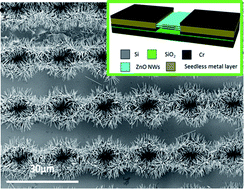Seedless synthesis of patterned ZnO nanowire arrays on metal thin films (Au, Ag, Cu, Sn) and their application for flexible electromechanical sensing
Abstract
The synthesis of high quality ZnO nanowire (NW) arrays on a range of conventional conductive substrates has important applications in LEDs, nanogenerators and piezotronics. In this paper, using ammonium hydroxide as the reactant, together with zinc nitrate hexahydrate, ZnO NW arrays have been grown on various patterned metal layers, such as Au, Ag, Cu and Sn, without pre-depositing a seed layer. The mechanism for this novel synthesis route has been discussed and the effect of parameters such as ammonia concentration and solution/container volume ratio on the nanowire growth has also been investigated. Preferentially selective nucleation and the subsequent growth of ZnO NW arrays was demonstrated on patterns of different metals without a ZnO seed. Electrical characterization was subsequently performed to reveal the characteristics of the contacts formed between the ZnO NWs and the underlying metal layer . Further demonstration of the as-fabricated ZnO NW arrays on flexible substrates as an electromechanical switch in response to externally applied strain exhibits the potential applications of the demonstrated seedless synthesis of patterned ZnO NW arrays in areas ranging from sensing, and energy harvesting to interfacing piezotronics with silicon based technologies.


 Please wait while we load your content...
Please wait while we load your content...